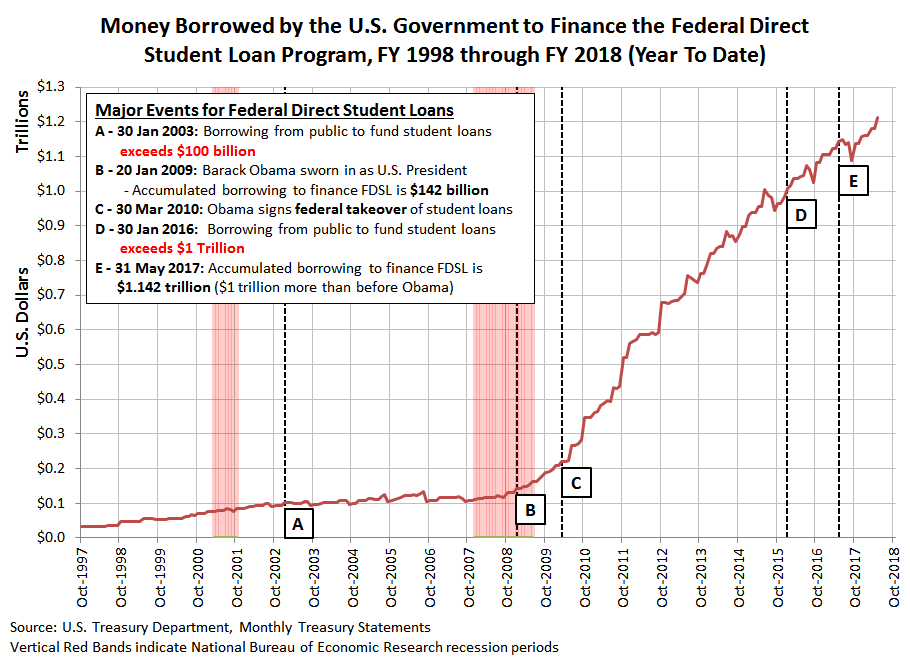On May 31, 2018, the total public debt outstanding of the U.S. government stood at $21.145 trillion dollars. Of that amount, $1.211 trillion was borrowed so that Uncle Sam could be in the business of making student loans.
[timeless]
Q1 hedge fund letters, conference, scoops etc, Also read Lear Capital: Financial Products You Should Avoid?
Over $1 trillion of that subtotal was borrowed after President Obama took over the student loan industry on March 30, 2010.
The Ugly Hockey Stick
As trends go, the chart of the history of the U.S. government’s borrowing to fund student loans looks like an ugly hockey stick, the kind that can have negative implications for the population, particularly those Americans who have a crippling level of student loan debt.
Laws make it nearly impossible for recipients of Federal Direct Student Loans to gain relief from the burden of debt.
So much so that a number of federal judges are now considering upending the laws written by Congress that make student loans largely exempt from being discharged in bankruptcy proceedings. These laws make it nearly impossible for recipients of Federal Direct Student Loans to gain relief from the burden of their having borrowed money from the U.S. government.
Katy Stech Ferek of the Wall Street Journal reports:
For decades, bankruptcy judges refused to consider reducing student loans. That is now changing, and some judges are throwing lifelines to people struggling to repay their debt.
In interviews with the Wall Street Journal, more than 50 current and former bankruptcy judges, frustrated at seeing borrowers leave federal courtrooms with six-figure debts, say they or their colleagues are more open to chipping away at the decades-old guidelines that determine how such debt is treated.
“If the law’s not going to be improved by Congress, we have to help these young people who are drowning in student loan debt,” said U.S. Bankruptcy Court Judge John Waites in South Carolina.
The articles go on to describe a number of remedies that U.S. judges are trying out, which are summarized in the following list:
- Issuing thorough, creative rulings in favor of borrowers that capture the consumer bankruptcy industry’s attention and lay the groundwork for other judges to rule similarly
- Cancelling private student loans spent on unaccredited schools, bar study expenses and other non-tuition related costs
- Clarifying that student loan borrowers should be allowed by trustees to make full loan payments during the chapter 13 repayment period, which typically lasts five years
- Agreeing to discharge the tax bill that a borrower in a federal student loan repayment program could face in 25 years for forgiven debt
- Encouraging lawyers to join nonprofit groups that represent student loan borrowers for free
While many of these judicial debt-relief strategies provide some benefit to those who have gone through the courts, by and large, the effects represent only a trivial nibbling around the edges of a much, much bigger problem.
The Government Is the Problem
The bigger problem is that the U.S. government is in the business of making student loans in the first place, where it has cumulatively borrowed more than a trillion dollars to be in that business. Because of its own massive borrowing, Uncle Sam cannot afford to let many student loan borrowers off the federal hook.
The bigger problem is that the U.S. government is in the business of making student loans in the first place.
That’s why when the government has provided relief to its stressed student loan borrowers, it has done so in the form of income-based repayment plans, which trade regular student loan payments for what amounts to a special additional income tax levied on the borrower.
There is a solution. The U.S. government can return the student loan business to the private sector, allowing lenders and academic institutions to assume the primary risks for when their students might default on their loans.
At the same time, Congress should rewrite the nation’s laws to once again make student loans fully dischargeable through bankruptcy proceedings. Just like almost every other kind of debt.
Until it does, that ugly hockey stick is only going to get uglier.
Reprinted from The Independent Institute.
Craig Eyermann
Craig Eyermann is a Research Fellow at the Independent Institute.
This article was originally published on FEE.org. Read the original article.
![]()

